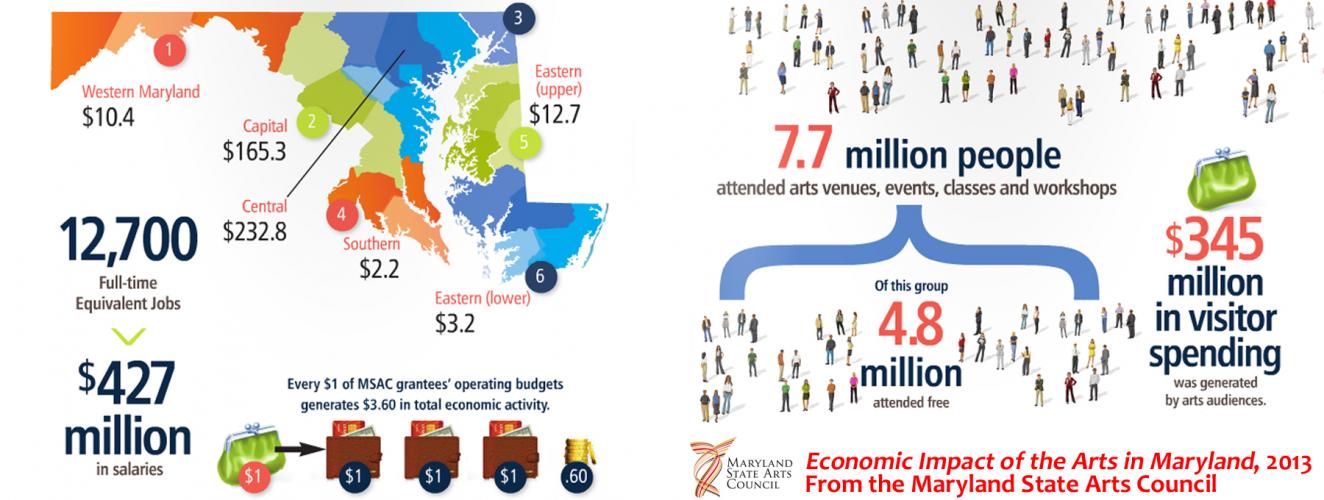Regional Arts & Culture Research and Reports:
Economic Impact of the Arts in MD Fiscal Year 2012 (Maryland State Arts Council)
Nonprofit arts support an annual economic impact of $1 billion in Maryland. This FY 2012 report shows how the arts support jobs, salaries, tax revenue and more.
Statewide Poll - The Arts in Maryland (Maryland State Arts Council)
At 81%, Marylanders overwhelmingly agree that “a vibrant arts community makes Maryland a better place to live,” according to a new statewide public opinion survey released today by the Maryland State Arts Council (MSAC). According to the poll results, two out of three Marylanders say the state should encourage and promote artistic expression and access to the arts, with top priorities for state support including art and creativity in communities, exposure to the arts in schools and opportunities for artists to be successful.
Maryland Arts and Entertainment Districts Economic and Fiscal Impact Analysis FY 2008-FY 2010 (Maryland State Arts Council)
The Maryland State Arts Council (MSAC) seeks a report detailing the economic and fiscal impacts of 19 Maryland Arts and Entertainment Districts (A&E districts) on Maryland’s economy.
UMBC Center for History Education
Regional History & Heritage Research and Reports:
Maryland Historical Trust's Inventory of Historic Properties
The Maryland Inventory of Historic Properties is a research and documentation instrument that serves as an archive of information to further the understanding of the State’s architectural, archeological, and cultural resources. To date, the MIHP is comprised of nearly 90,000 resources, composed of archaeological sites, building, structures, objects and survey districts. A Maryland Inventory form provides a description of historic resource and discusses its history, but the MIHP is not a regulatory instrument, and the determination of a resource’s historic significance is not a requirement for inclusion.
List of Maryland's Heritage Areas
Maryland’s Heritage Areas are locally designated and State certified regions where public and private partners make commitmentsto preservinghistorical, cultural and natural resources for sustainable economic development through heritage tourism. Click on the map below to learn more about each of these special places.
PreserveMaryland 2014 Preservation Plan
For more than a century, Marylanders have worked to preserve the historic buildings, landscapes and towns that tell the state’s unique story. From Civil War battlefields to Victorian-era inns to African American cemeteries, advocates have come together to recognize, rescue and restore diverse historic places across the state.
To build on those efforts and address new challenges, PreserveMaryland, a five-year plan produced by the Maryland Historical Trust, charts a way for the historic preservation community to work more effectively to protect the state’s historic and cultural heritage.
Arts Education in Maryland Research and Reports:
The Governor’s P-20 Leadership Council Task Force on Arts Education in Maryland Schools - Final Report
Making the Connection Between Arts Education and Current Research (AEMS: Arts Education in Maryland Schools)
A growing body of studies, including those in the research compendium Critical Links: Learning in the Arts and Student Academic and Social Development, presents compelling evidence connecting student learning in the arts to a wide spectrum ofacademic and social benefits. The compendium includes summaries of 62 arts education studies conducted in five major art form areas: dance, drama, visual arts, music and multi-arts. These studies and related essays document the habits of mind, social competencies and personal dispositions inherent to arts learning.
Arts Education Advocacy Guide (AEMS: Arts Education in Maryland Schools)
National Arts and Culture Research and Resports:
How it's Being Done: Art Business Training Across the U.S.
This research seeks to answer the question “How is business training being delivered to artists across the U.S.?” Artists need to proactively manage the business side of their creative practice, often approaching their practice as an entrepreneurial endeavor, particularly as public funding for the arts has declined and funding for individual artists is especially difficult to find. To support their efforts, state and local agencies, artist services organizations, universities and others are providing training, resources, and technical services directly to artists. We have identified 163 programs or services offered by 79 different organizations1 or individuals that provide arts business training or resources of various types to individual artists and the leaders of small arts organizations.
Thriving Arts Organizations, Thriving Arts: What We Know About Building Audiences for the Arts and What We Still Have To Learn
The Road to Results: Effective Practices for Building Arts Audiences
This publication details the experiences of 10 such organizations that were among 54 arts institutions that received funding from The Wallace Foundation between 2006 and 2012 to develop audience-building initiatives. An analysis of these programs—each supported by evaluation data—revealed nine practices contributing to their success.
How Cultural Institutions are Embracing Digital Technology
Like, Link, Share is a report and accompanying website released in December 2014, that highlights examples and lessons learned from legacy cultural institutions that are successfully embracing digital media in their work, whether in artistic creation and artistic programs, audience engagement activities, fund development, operations, or in all of these. The goal is to describe the distinctive leadership and organizational capacities required for pioneering work, and to help trustees, grantmakers, and colleague institutions understand the conditions needed and actions taken for success in our increasingly digital culture. Thewebsite, created as an active gallery examples, is also a rich resource of links to projects, social media sites, research reports, and funding information about the 40 international organizations included.
Arts & the Economy: Using Arts and Culture to Stimulate State Economic Development, 2009 (National Governors Association Center for Best Practices)
Arts and culture are important to state economies. Arts and culture-related industries, also known as “creative industries,” provide direct economic benefits to states and communities: They create jobs, attract investments, generate tax revenues, and stimulate local economies through tourism and consumer purchases. These industries also provide an array of other benefits, such as infusing other industries with creative insight for their products and services and preparing workers to participate in the contemporary workforce. In addition, because they enhance quality of life, the arts and culture are an important complement to community development, enriching local amenities and attracting young professionals to an area.
Why Should Government Support the Arts? (National Assemble of State Arts Agencies)
State governments today are wrestling with fundamental questions: What are the appropriate roles, responsibilities and size of government? How can states ensure long-term productivity and economic competitiveness? What solutions are available for chronic challenges in education, health care and employment? While seeking answers to these questions, public managers and elected officials must uphold the principles that taxpayers expect: thrift, accountability, equity and transparency.
Americans for the Arts Creative Industries Reports
By documenting Dun & Bradstreet business and employment data for both the nonprofit and for-profit arts sectors, you can paint a picture of a powerful engine in your community's information economy. What makes this data especially potent is that it can be localized to any city, county, state, region, or political jurisdiction in the country, and it can be updated regularly so that you can track trend data. You can also take a look at our most current standard reports* by exploring the links below.
Americans for the Arts Research
2013 Business Support for the Arts Survey
Community Development Investment Review: Creative Placemaking
Miscelaneous Research and Reports:
Maryland Civic Health Index 2010
In this, the first-ever Maryland Civic Health Index, the Free State finds itself ahead of the national average on almost every major indicator of civic health. Marylanders are highly connected to information, discuss issues and politics often, and vote in greater proportions than the national average. More Maryland citizens are members of organized groups and are leaders of those groups than is the national norm



